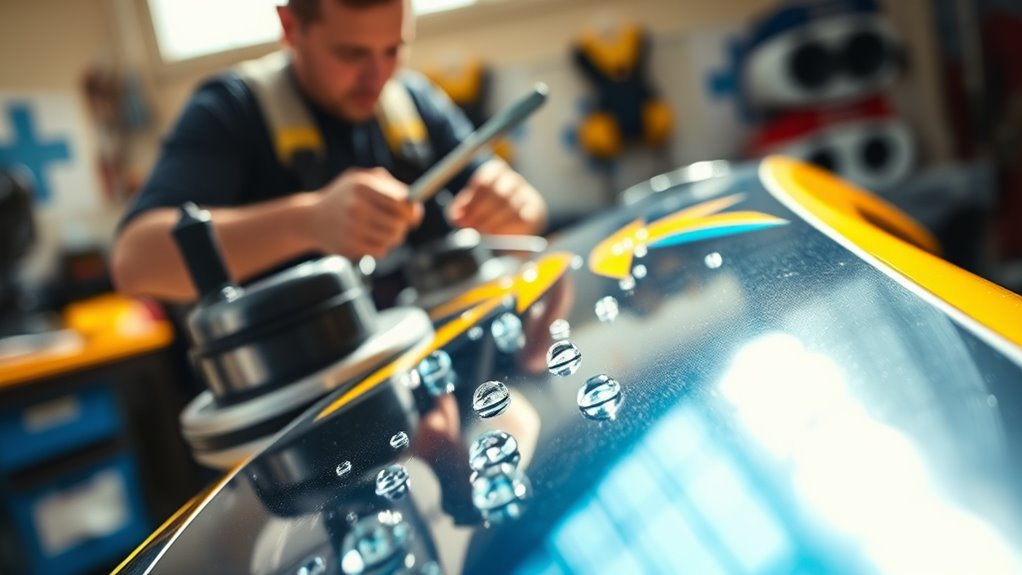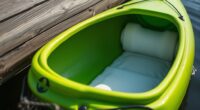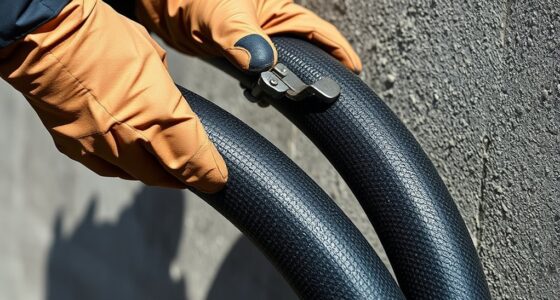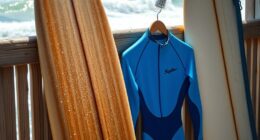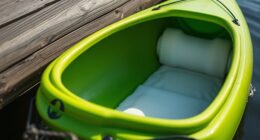To keep your flyboarding equipment in top shape, regularly inspect the hydraulic systems for leaks, and guarantee all connections are secure. Clean the jet pump after each use to prevent debris buildup and corrosion, focusing on the impeller and nozzle. Store your gear in a cool, dry place, using protective covers against dust and moisture. By following these maintenance tips, you’ll enhance your flyboarding experience and ensure safety, performance, and longevity. Discover more essential care practices next!
Key Takeaways
- Regularly inspect the hydraulic system for leaks, wear, and secure connections to ensure optimal performance and safety.
- Clean the jet pump after each use to prevent corrosion and maintain efficiency in thrust components.
- Store flyboarding equipment in a cool, dry place with protective covers to shield against dust and moisture.
- Follow the user manual for specific maintenance routines to extend the longevity of your gear.
- Address any issues promptly to avoid escalation and enhance your overall flyboarding experience.

Have you ever wondered how to keep your flyboarding equipment in top shape? Maintaining your gear is essential for both performance and safety, and it starts with understanding the components involved. Your hydraulic system plays a pivotal role in how well your equipment functions. If you neglect it, you might face issues that can lead to a less-than-stellar experience on the water.
First, regularly inspect your hydraulic system for leaks or any signs of wear. Check the hoses and fittings, ensuring they’re secure and free from cracks or frays. A simple visual inspection can help you catch small problems before they escalate into bigger issues. If you notice anything unusual, it’s best to consult a professional to avoid compromising your safety while flyboarding. Remember, a well-functioning hydraulic system not only enhances your performance but also guarantees you have a smooth ride.
Regularly inspect your hydraulic system for leaks and wear to ensure optimal performance and a smooth flyboarding experience.
Next, don’t overlook your jet pump. It’s imperative to clean it after each use to prevent debris from building up. Rinse off any saltwater or sand, as these elements can corrode the components over time. Pay close attention to the impeller and nozzle, as they can become clogged, affecting your thrust. Make it a habit to perform this routine maintenance; it’ll save you time and money in the long run.
When it comes to storage safety, you want to make sure your equipment is stored correctly, especially during off-seasons. Keep your flyboarding gear in a cool, dry place. Avoid leaving it exposed to extreme temperatures, as this can damage the materials. Use protective covers to shield your gear from dust and moisture. If you have a watercraft, ensure it’s stored properly to prevent any accidental damage to your flyboarding equipment.
Additionally, consider using a dedicated storage rack or case. This not only keeps your equipment organized but also protects it from potential hazards. If you’re stacking gear, make sure it’s balanced and secure to avoid any accidents.
Lastly, always keep the user manual handy. It contains specific guidelines for your equipment and can help you troubleshoot minor issues. Following these maintenance tips will help guarantee your flyboarding experience remains enjoyable and safe. By taking care of your gear, you’re investing in countless thrilling rides to come. So gear up, stay safe, and enjoy every moment on the water!
Moreover, maintaining your gear fosters the father-daughter bond that can be strengthened through shared activities and experiences in flyboarding.
Frequently Asked Questions
What Is the Lifespan of a Flyboarding Jetpack?
A flyboarding jetpack typically lasts around 5 to 10 years, depending on its durability and how well you maintain it. If you’re diligent with maintenance frequency, checking for wear and tear regularly, you can extend its lifespan. Factors like usage intensity and environmental conditions also play a role. So, by taking proper care of your jetpack, you’ll enjoy many thrilling sessions on the water while ensuring its longevity.
Can I Flyboard in Saltwater?
Absolutely, you can flyboard in saltwater! However, it’s wise to keep in mind that saltwater corrosion can be a sneaky adversary to your gear. After your thrilling session, make sure to give your equipment a thorough cleaning to keep it in tip-top shape. A gentle rinse with fresh water can help fend off any potential damage, ensuring your flyboarding experience remains delightful and your gear lasts for many more adventures.
How Do I Choose the Right Flyboarding Equipment?
To select the right flyboarding equipment, consider your skill level and the type of water you’ll be in. Look for a reliable jetpack and board that match your experience. Don’t forget safety gear, like a helmet and life vest, to keep you protected. Also, check maintenance tips for the equipment to guarantee it’s in top shape. Investing in quality gear will enhance your experience and safety on the water.
Are There Weight Limits for Flyboarding?
Absolutely, there are weight limits for flyboarding. Think of it as a dance on water; too much weight can throw off the balance. Most equipment has weight restrictions, typically ranging from 100 to 250 pounds. Staying within these limits guarantees your safety and the equipment’s performance. So, when you’re gearing up for that exhilarating flight, keep those weight restrictions in mind; it’s all about maximizing your enjoyment while staying safe!
Where Can I Find Flyboarding Lessons?
You can find flyboarding lessons through local instructors and training courses in your area. Search online for water sports schools or rental shops that offer flyboarding. They often provide certified instructors who can teach you the basics and help you gain confidence on the board. Don’t forget to read reviews and check their safety protocols. With a little research, you’ll be soaring in no time!
Conclusion
In the world of flyboarding, keeping your equipment in top shape is like tuning a finely crafted instrument before a big performance. Just as a musician can’t hit the right notes with a broken string, you can’t soar through the skies without well-maintained gear. By regularly checking and repairing your equipment, you’re not just ensuring safety; you’re also enhancing your experience on the water. So, immerse yourself in maintenance and let your flyboarding adventures reach new heights!

